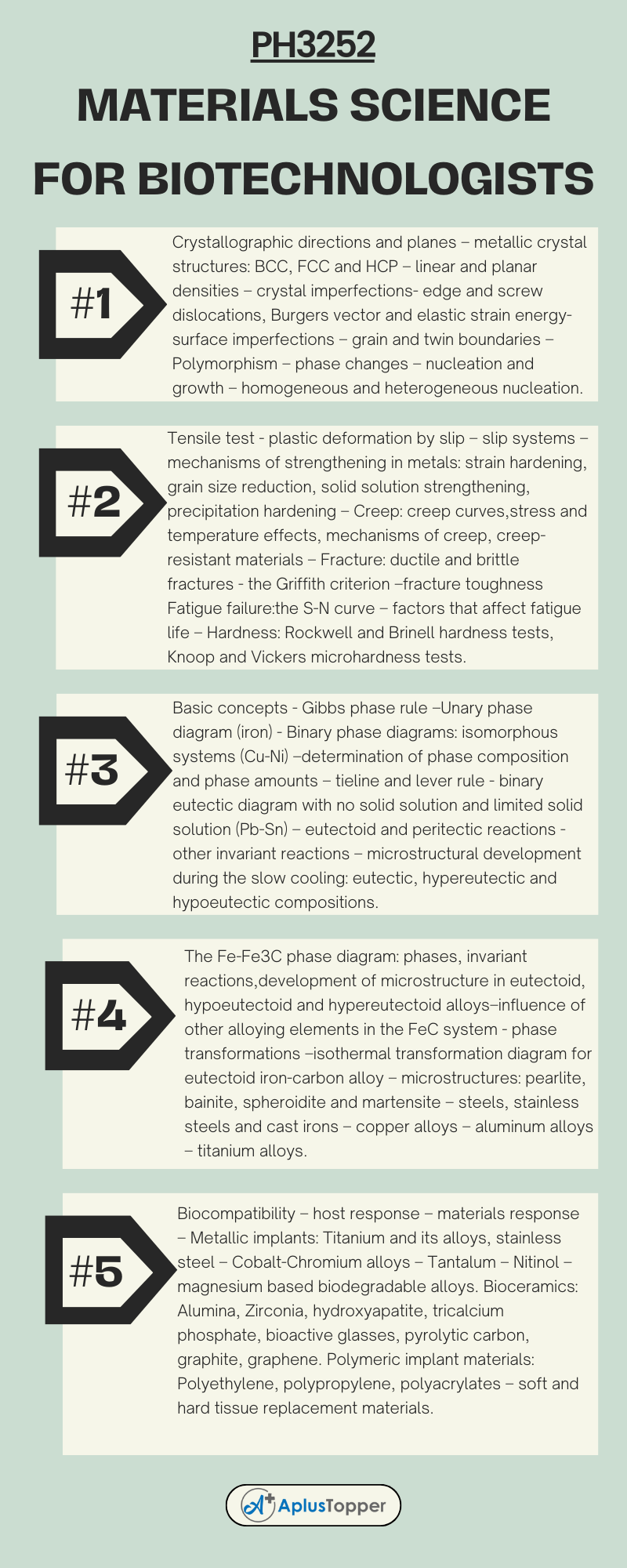Subject code PH3252 deals with the semester II subject syllabus from Anna University 2021 relevant to affiliated institutions. In this article, we would like to introduce the syllabus of the PH3252 – Materials Science For Biotechnologists in B.Tech Biotechnology and Biochemical Engineering.
We like to provide the PH3252 – Materials Science For Biotechnologists syllabus for students to perform well academically. This article will assist the students in getting the required syllabus for each unit with different concepts. We include expert textbooks and references for students to avoid confusion when reading books. The following links will help you to select the subject you want to read. Hope this information is useful. Don’t forget to share this information with your friends.
If you want to know more about the syllabus of B.Tech Biotechnology and Biochemical Engineering Syllabus connected to an affiliated institution’s four-year undergraduate degree program. We provide you with a detailed Year-wise, semester-wise, and Subject-wise syllabus in the following link B.Tech Biotechnology and Biochemical Engineering Syllabus Anna University, Regulation 2021.
Aim Of Concept:
- To make the students effectively understand the basics of crystallography and crystal imperfections.
- To enable the students to get knowledge on various strengthening methods of materials, and also various mechanical properties and their measurement.
- To impart knowledge on the basics of phase diagrams and their applications.
- To learn about iron-carbon systems and various ferrous and non-ferrous alloys.
- To introduce different types of biomaterials and their applications.
PH3252 – Materials Science For Biotechnologists Syllabus
Unit I: Crystallography
Crystallographic directions and planes – metallic crystal structures: BCC, FCC, and HCP – linear and planar densities – crystal imperfections- edge and screw dislocations, Burgers vector and elastic strain energy- surface imperfections – grain and twin boundaries – Polymorphism – phase changes – nucleation and growth – homogeneous and heterogeneous nucleation.
Unit II: Mechanical Properties
Tensile test – plastic deformation by slip – slip systems – mechanisms of strengthening in metals: strain hardening, grain size reduction, solid solution strengthening, precipitation hardening – Creep: creep curves, stress and temperature effects, mechanisms of creep, creep-resistant materials – Fracture: ductile and brittle fractures – the Griffith criterion –fracture toughness Fatigue failure: the S-N curve – factors that affect fatigue life – Hardness: Rockwell and Brinell hardness tests, Knoop and Vickers microhardness tests.
Unit III: Phase Diagrams
Basic concepts – Gibbs phase rule –Unary phase diagram (iron) – Binary phase diagrams: isomorphous systems (Cu-Ni) –determination of phase composition and phase amounts – tieline and lever rule – binary eutectic diagram with no solid solution and limited solid solution (Pb-Sn) – eutectoid and peritectic reactions – other invariant reactions – microstructural development during the slow cooling: eutectic, hypereutectic and hypoeutectic compositions.
Unit IV: Ferrous And Nonferrous Alloys
The Fe-Fe3C phase diagram: phases, invariant reactions, development of microstructure in eutectoid, hypoeutectoid and hypereutectoid alloys–influence of other alloying elements in the FeC system – phase transformations –isothermal transformation diagram for eutectoid iron-carbon alloy – microstructures: pearlite, bainite, spheroidite and martensite – steels, stainless steels and cast irons – copper alloys – aluminum alloys – titanium alloys.

Unit V: Materials For Biological Applications
Biocompatibility – host response – materials response – Metallic implants: Titanium and its alloys, stainless steel – Cobalt-Chromium alloys – Tantalum – Nitinol – magnesium-based biodegradable alloys. Bioceramics: Alumina, Zirconia, hydroxyapatite, tricalcium phosphate, bioactive glasses, pyrolytic carbon, graphite, graphene. Polymeric implant materials: Polyethylene, polypropylene, polyacrylates – soft and hard tissue replacement materials.
Text Books:
- R. Balasubramaniam, Callister’s Materials Science and Engineering.Wiley (Indian Edition), 2014.
- V.Raghavan. Materials Science and Engineering: A First Course, Prentice Hall India Learning Private Limited, 2015.
- Joon Park and R.S.Lakes, Biomaterials: An Introduction, Springer, 2007.
References:
- J.F.Shackelford. Introduction to Materials Science for Engineers. Pearson, 2015.
- Wendelin Wright and Donald Askeland, Essentials of Materials Science and Engineering, CL Engineering, 2013.
- J.C. Anderson, K.D. Leaver, P. Leevers and R.D. Rawlings, Materials Science for Engineers, CRC Press, 2003.
- Jean P.Mercier, G.Zambelli and W.Kurz, Introduction to Materials Science, Elsevier, 2002.
- Sujata V.Bhat, Biomaterials, Narosa Publishers, 2002
Related Posts On Semester – II:
- HS3252 – Professional English – II
- MA3251 – Statistics and Numerical Methods
- BE3252 – Basic Electrical, Electronics and Instrumentation Engineering
- GE3251 – Engineering Graphics
- GE3252 – தமிரு் ததொழி்நு்பமு் /Tamils and Technology
Must Read For More:
